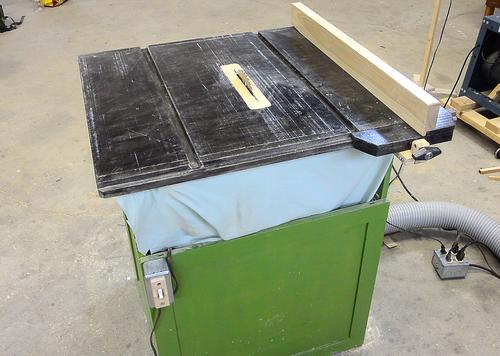 I built my first homemade table saw
(shown here) to see how good a homemade
table saw I could build from a hand-held circular saw.
I built my first homemade table saw
(shown here) to see how good a homemade
table saw I could build from a hand-held circular saw.
 I built my first homemade table saw
(shown here) to see how good a homemade
table saw I could build from a hand-held circular saw.
I built my first homemade table saw
(shown here) to see how good a homemade
table saw I could build from a hand-held circular saw.
A proper table saw would ideally have a proper arbour shaft and be powered by an induction motor, but that would require some precision-machined parts. The best way to get these precision made parts is out of an old table saw, which would defeat the purpose of building one. So I based it on a hand-held circular saw instead.
I put this table saw out in my big garage workshop in the country. It's the only table saw I had out there, and I ended up using it quite a bit. It's not as good or as precise as a contractor style saw made of cast iron, but it got the job done.
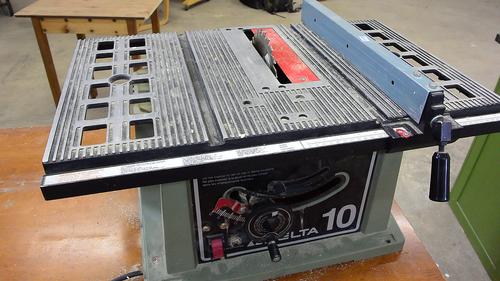 But really, you can buy a cheap new table saw sometimes for as low as $100.
So it doesn't make that much sense to build a table saw, does it?
But really, you can buy a cheap new table saw sometimes for as low as $100.
So it doesn't make that much sense to build a table saw, does it?
Last year, my friend Bill Price gave me one of these cheap table saws for free. I figured "that was silly of me, building one, when now I have this one for free!". But then I started to play around with it. The whole thing just seems loud, imprecise and dangerous. I was much more comfortable using my homemade one.
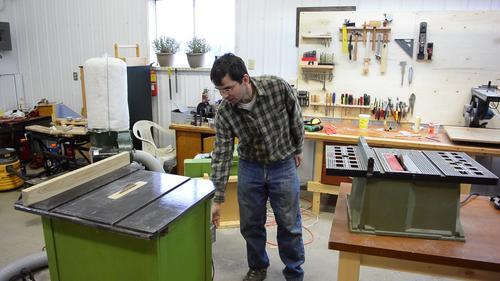 Comparing sound levels, with auto volume adjust on the camera turned off,
I confirmed: the 10" delta was indeed much louder!
Comparing sound levels, with auto volume adjust on the camera turned off,
I confirmed: the 10" delta was indeed much louder!
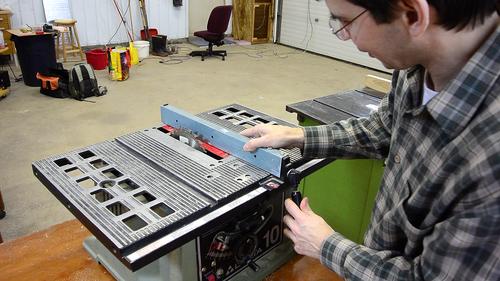 The table on this saw on this saw is way too small. The fence
is flimsy, and there is a huge space around the blade, making the saw unsafe
to use with anything small.
The table on this saw on this saw is way too small. The fence
is flimsy, and there is a huge space around the blade, making the saw unsafe
to use with anything small.
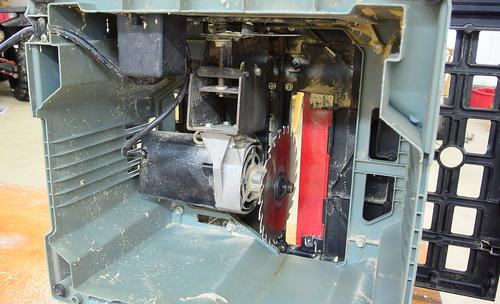 Looking in the bottom of the saw, the mechanism is made of stamped sheet metal,
with the motor only supported on one side. There's some play in
the mechanism too. And it's all supported by this very flimsy plastic stand.
Looking in the bottom of the saw, the mechanism is made of stamped sheet metal,
with the motor only supported on one side. There's some play in
the mechanism too. And it's all supported by this very flimsy plastic stand.
Sadly, any table saw in the less-than-$200 price range is built
in much the same way. This type of saw might be ok for ripping the occasional
2x4 down the middle on a construction site, but I don't think it's suitable
for anything one might describe as "woodworking". In fact,
just the force of turning the motor on makes the blade jump a little.
That said. Steve Ramsey did
manage to use one like that until 2011. For example in
this video.
Maybe I'm a tool snob.
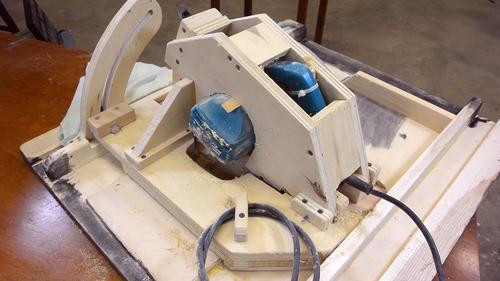 On my homemade table saw, the mechanism that holds the motor is much more solid,
and the motor is supported on both sides. This makes for a much more stable
arrangement. But the arbour is not as solid as it is in a proper cast
iron table saw. Handheld circular saws are only so good, unless you are willing
to buy a Festool saw. But those cost more than decent table saws, so that
would be silly (at least for this purpose).
On my homemade table saw, the mechanism that holds the motor is much more solid,
and the motor is supported on both sides. This makes for a much more stable
arrangement. But the arbour is not as solid as it is in a proper cast
iron table saw. Handheld circular saws are only so good, unless you are willing
to buy a Festool saw. But those cost more than decent table saws, so that
would be silly (at least for this purpose).
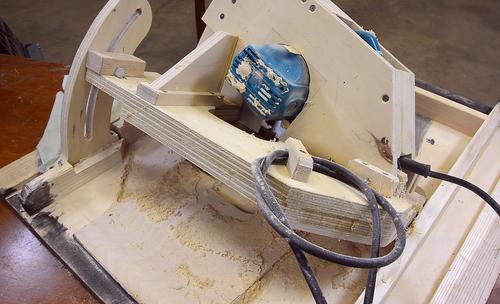 Dust accumulation inside the saw is a problem, and the air inlet to the motor
got partially plugged up over time. Partly this is because the dust chute on the blade
guard plugged up, and I never checked it. I have an idea for improving this aspect.
Dust accumulation inside the saw is a problem, and the air inlet to the motor
got partially plugged up over time. Partly this is because the dust chute on the blade
guard plugged up, and I never checked it. I have an idea for improving this aspect.
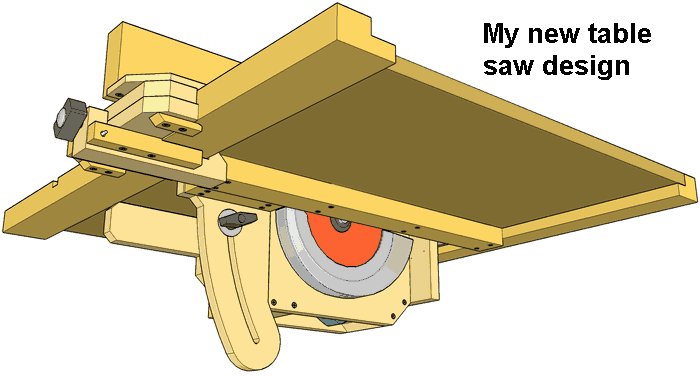 This table saw also had some tricky aspects to its construction. For my new design,
I simplified it quite a bit. I also removed the tilting ability. Tilt can be useful,
but it complicates the mechanism quite a bit, and by eliminating it I can reinforce
the table much better, which means the table doesn't need to be made out of high
quality plywood. The idea is to make this a cheap and accessible project.
This table saw also had some tricky aspects to its construction. For my new design,
I simplified it quite a bit. I also removed the tilting ability. Tilt can be useful,
but it complicates the mechanism quite a bit, and by eliminating it I can reinforce
the table much better, which means the table doesn't need to be made out of high
quality plywood. The idea is to make this a cheap and accessible project.
Having said all that, if you are willing to spend $500 on a new table saw (benchtop or contractor style) or if you can find a used cast iron contractor style saw (with a cast iron table), either option will be a better saw than you can build yourself. But new table saws for under $200 tend to be junk.
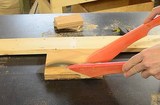 Improvised table saw
Improvised table saw